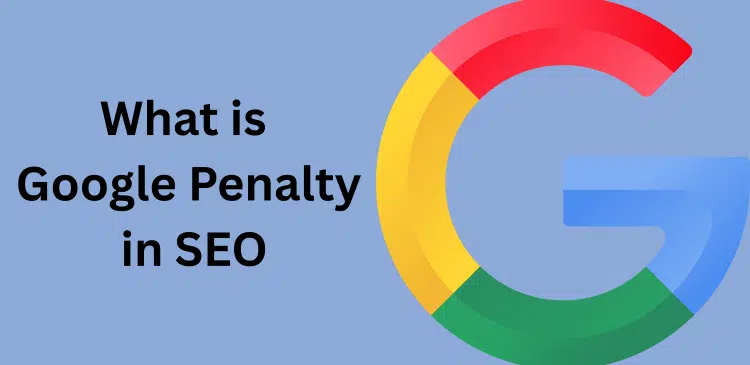What is Google Penalty in SEO

A Google penalty in the context of SEO refers to occurrences which may have a strong negative effect on the ranking of any website on the Google search engine. It is important for the website owners as well as the digital marketers to understand what a Google penalty is and why it happens, as well as on how to go about recovering from a penalty. The purpose of this article is to explain Google penalties in a simple language to the readers.
What is a Google Penalty?
A Google penalty entails a drop of the site’s rank on the Google search engine or a ban from Google index due to violation of Google’s Webmaster policies. These penalties are however exercised by Google in order to ensure that Sites provide high quality and credible results to user’s queries. When it comes to categorizing Google penalties, then there are two main ones which include the manual and the algorithmic ones.
Manual Penalties
Manual penalties are the type of penalties given by Google spam team after they’ve had an eye on a given site. If a website violates the rules defined by Google, the company sanctions it in what is referred to as a manual action. This can be through the reporting from the users or may be carried out independently by Google. These penalties can vary from a message being sent in Google Search Console to penalties such as demotion to another website rank level or complete removal from the Google search results.
Common Reasons for Manual Penalties
Cloaking: Practice of presenting one set of webpages to searchers and another to the search engine.
Blind Text and Links: These are the texts or links that may not be easily seen by any user who visits the site, but they are visible to the search engines.
Duplicate Content: It refers to the act of reposting the same content on different web pages.
Paid Links: The links that are purchased in any way and are against Google’s Webmaster Guidelines.
Algorithmic Penalties
Algorithmic penalties are those which arise in the event that Google brings in new algorithms to punish such sites that are involved in the black-hat SEO. Unlike the manual penalties it is automated hence can affect tens of thousands of websites at a go. Panda, Penguin and Hummingbird are examples of an update that can lead to algorithmic penalties in many websites.
Common Algorithm Updates
Panda Update: It is an update that lowers the website’s rank if the content is low quality or scrupulous content, duplicate, or spinning content.
Penguin Update: Aims at demoting web-sites that engaged built links through the use of black-hat SEO techniques.
Identifying a Google Penalty
Google’s signal or sign of your web page penalty is an important change that can help site owners be quick to fix problems that need to be fixed on their web page’s place. Here is a list of signs that your website has been punished.
The following are some of the signs that may indicate a site has been penalized:
Sudden Drop in Traffic: Decreased ranking of your website on search engines for the easiest keywords that you were targeting.
Low CTR (Click Through Rate): A significant decrease in the users to click on your website link after the search.
Messages in Google Search Console: Any kind of messages such as warnings or notification regarding any manual actions taken against your website.
Recovering from a Google Penalty
While it is not an easy task to undertake especially if the business entirely depends on the search engines for traffic, it is not impossible to recover from the hilt given that certain measures are put in place.
This is how the process of addressing and rectifying the problem should be done:
Step 1: Diagnose the Issue
The first thing, which needs to be defined, is the kind of the penalty under consideration. This can be done by going to the ‘Notifications’ section to check for any messages concerning a manual action being taken against the site. If the penalty is algorithmic, attempt to discover which of the current algorithm changes is suspected and this can be done by going through news articles and forums.
Step 2: Fix the Problem
Once you find out the reason that you have been penalized you need to make some changes that will ensure that you are now following Google’s rules and regulations.
Create or Edit Content: Edit or create content by following Google’s rules and regulations.
Eliminate Cloaking: It is hard to provide search engines relevant contents if you provide different contents to search engines than what you provide to the users.
Remove any Paid Links: If necessary, mark them with Google’s disavow tool.
Improve Readability: Revive thin content or duplicate content to be relevant to the end-users.
Step 3: Submit a Reconsideration Request
In the case that a manual penalty has been assigned, then one has to write a reconsideration request to Google after the changes have been made.
This involves:
- Recall all the actual steps that have been taken in order to solve the problems.
- Provide evidence that the problems have been fixed, an aspect that has been well handled in the experiment.
- Another way of submitting the request is through Google Search Console.
Step 4: Monitor Your Progress
Having made the changes, simply resubmit the request by paying attention to the new performance data of your website. Measure the patterns and progress of traffic increases and ranking conditions. You should constantly turn to Google Search Console for information of your site’s status.
